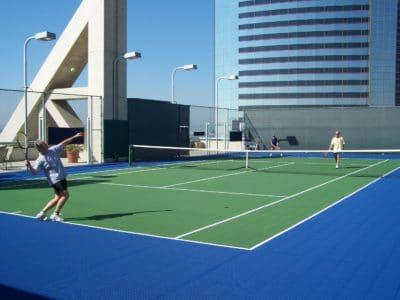So you’re ready to add a new sports court or upgrade an existing one? Great.
But just how long are you going to have to wait until your visitors are serving aces and draining jumpers? Good question.
Neave Sports is an authorized Flex Court Athletics dealer and we know the Flex Court installation process front to back. That said, our answer really depends on two things:
- Are we installing Flex Court tiles over an existing sport surface?
- Or will a subsurface need to be installed before the tiles go down?
With both circumstances in mind, let’s take a closer look at what most homeowners can expect as a typical Flex Court installation timeline.
The Flex Court Installation Timeline
For homeowners starting from scratch, here’s what to expect:
- Create a court design for your property using Neave Sports’ Custom Court Builder.
- Conduct a property walk through with a Neave Sports specialist.
- Establish a timeline for the project, from breaking ground to completion (aka play ball!).
- Obtain permits from proper municipal departments (Neave Sports will take care of this).
- If necessary, perform rough grading for base surface.
- Install base surface and on-court components (think hoops and net posts).
- Apply Flex Court outdoor tiles to base surface.
- Install add-on/landscape enhancements (fencing, lighting, plantings, seating, etc.)
- Conduct final inspection.
- Game on!
Retrofitting An Existing Sport Surface With Flex Court Tiles?
While a Flex Court project that includes installing a base surface first can take about two weeks to complete, retrofitting a pre-existing (and deteriorating) sport surface can take only two or three days. The retrofit process generally looks a lot like this:
- Prep old surface: Scrape away loose materials, clean out cracks, seal them and perform any necessary leveling. Allow sealing and leveling to cure.
- Install your custom-designed Flex Court sport surface. And you’re good to go.
Why Choose Flex Court Tiles Over A Traditional Sports Surface?
We’re confident you’ve done your homework on Flex Court tiles — and just in case you haven’t, check out our free e-book:
The Essential Flex Court Athletics Buyer’s Guide
When comparing Flex Court tiles to traditional sport surfaces, the advantages are hard to ignore. Flex Court tiles are made of a high-density polypropylene, virgin-resin with UV and oxidation protection. Some of its design advantages include:
- Self-draining (no puddles!)
- Shock absorbent (recommended by orthopedic surgeons)
- Low maintenance (maintenance costs are 50 percent less than traditional surfaces)
- Customizable size and color combinations
- Retrofitting is a snap (literally). The interlocking tiles snap together for a quick installation over a concrete pad.
Let Neave Sports Make Your Flex Court Installation A Snap
 At Neave Sports, we know how to make the process of designing your next sport surface easy, engaging and quick. Just pick your sport (or sports). Choose your colors. And before you know it, a Neave Sports client care specialist will get in touch with you to get to work.
At Neave Sports, we know how to make the process of designing your next sport surface easy, engaging and quick. Just pick your sport (or sports). Choose your colors. And before you know it, a Neave Sports client care specialist will get in touch with you to get to work.
From securing proper building permits to preparing the terrain, installing the base surface and tiles to adding lighting and surrounding landscaping, we do it all. We can even provide the high-quality hoops and nets for your court.
The best part? You’ll work with a single dedicated point person at Neave to ensure your goals, needs, and budget concerns are heard loud and clear.
If you’re ready to step your game up and live in the Hudson Valley, call us at (845) 463-0592. If you’re in Westchester County, call (914) 271-7996; from Connecticut, dial (203) 212-4800. Or, fill out our simple web form, and we’ll contact you about setting up your free consultation.